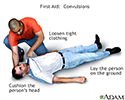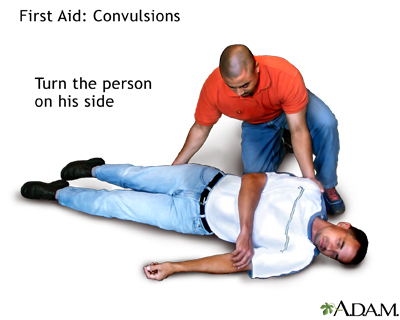Seizures
Secondary seizures; Reactive seizures; Seizure - secondary; Seizure - reactive; Convulsions
A seizure is the physical findings or changes in behavior that occur after an episode of abnormal electrical activity in the brain.
The term "seizure" is often used interchangeably with "convulsion." During convulsions a person has uncontrollable shaking that is rapid and rhythmic, with the muscles contract and relax repeatedly. There are many different types of seizures. Some have mild symptoms without shaking.
Considerations
It may be hard to tell if someone is having a seizure. Some seizures only cause a person to have staring spells . These may go unnoticed.
Staring spells
An absence seizure is the term for a type of seizure involving staring spells. This type of seizure is a brief (usually less than 15 seconds) distur...

Specific symptoms depend on which part of the brain is involved. Symptoms occur suddenly and may include:
- Brief blackout followed by a period of confusion (the person cannot remember for a short time)
- Changes in behavior, such as picking at one's clothing
- Drooling or frothing at the mouth
- Eye movements
- Grunting and snorting
- Loss of bladder or bowel control
- Mood changes, such as sudden anger, unexplainable fear, panic, joy, or laughter
- Shaking of the entire body
- Sudden falling
- Tasting a bitter or metallic flavor
- Teeth clenching
- Temporary stop in breathing
- Uncontrollable muscle spasms with twitching and jerking limbs
Symptoms may stop after a few seconds or minutes, or continue for up to 15 minutes. They rarely continue longer.
The person may have warning symptoms before the attack, such as:
- Fear or anxiety
- Nausea
- Vertigo (feeling as if you are spinning or moving)
- Visual symptoms (such as flashing bright lights, spots, or wavy lines before the eyes)
Causes
Seizures of all types are caused by disorganized and sudden electrical activity in the brain.
Causes of seizures can include:
- Abnormal levels of sodium or glucose in the blood
-
Brain infection, including
meningitis
Meningitis
Meningitis is an infection of the membranes covering the brain and spinal cord. This covering is called the meninges.
 ImageRead Article Now Book Mark Article
ImageRead Article Now Book Mark Article - Brain injury that occurs to the baby during labor or childbirth
- Brain problems that occur before birth (congenital brain defects)
-
Brain tumor
(rare)
Brain tumor
A brain tumor is a group (mass) of abnormal cells that start in the brain. This article focuses on primary brain tumors in children.
 ImageRead Article Now Book Mark Article
ImageRead Article Now Book Mark Article -
Drug abuse
Drug abuse
Substance use is the continued use of alcohol, illegal drugs, or the misuse of prescription or over-the-counter drugs with negative consequences. Th...
Read Article Now Book Mark Article -
Electric shock
Electric shock
An electrical injury is damage to the skin or internal organs when a person comes into direct contact with an electrical current.
 ImageRead Article Now Book Mark Article
ImageRead Article Now Book Mark Article -
Epilepsy
Epilepsy
Epilepsy is a brain disorder in which a person has repeated seizures over time. Seizures are episodes of uncontrolled and abnormal firing of brain c...
 ImageRead Article Now Book Mark Article
ImageRead Article Now Book Mark Article -
Fever
(particularly in
young children
)
Fever
Fever is the temporary increase in the body's temperature in response to a disease or illness. A child has a fever when the temperature is at or abov...
 ImageRead Article Now Book Mark Article
ImageRead Article Now Book Mark ArticleYoung children
A febrile seizure is a convulsion in a child triggered by a fever.
 ImageRead Article Now Book Mark Article
ImageRead Article Now Book Mark Article -
Head injury
Head injury
A head injury is any trauma to the scalp, skull, or brain. The injury may be only a minor bump on the skull or a serious brain injury. Head injury c...
 ImageRead Article Now Book Mark Article
ImageRead Article Now Book Mark Article - Heart disease
-
Heat illness (
heat intolerance
)
Heat intolerance
Heat intolerance is a feeling of being overheated when the temperature around you rises. It can often cause heavy sweating. Heat intolerance usually...
Read Article Now Book Mark Article - High fever
-
Phenylketonuria (
PKU
), which can cause seizures in infants
PKU
Phenylketonuria (PKU) is a rare condition in which a baby is born without the ability to properly break down an amino acid called phenylalanine....
 ImageRead Article Now Book Mark Article
ImageRead Article Now Book Mark Article - Poisoning
- Street drugs, such as angel dust (PCP), cocaine, amphetamines
-
Stroke
Stroke
A stroke occurs when blood flow to a part of the brain stops. A stroke is sometimes called a "brain attack. " If blood flow is cut off for longer th...
 ImageRead Article Now Book Mark Article
ImageRead Article Now Book Mark Article -
Toxemia of pregnancy
Toxemia of pregnancy
Preeclampsia is when a pregnant woman develops high blood pressure and protein in the urine after the 20th week of pregnancy.
 ImageRead Article Now Book Mark Article
ImageRead Article Now Book Mark Article -
Toxin buildup in the body due to liver or
kidney failure
Kidney failure
Acute kidney failure is the rapid (less than 2 days) loss of your kidneys' ability to remove waste and help balance fluids and electrolytes in your b...
 ImageRead Article Now Book Mark Article
ImageRead Article Now Book Mark Article -
Very high blood pressure (
malignant hypertension
)
Malignant hypertension
Malignant hypertension is very high blood pressure that comes on suddenly and quickly.
 ImageRead Article Now Book Mark Article
ImageRead Article Now Book Mark Article -
Venomous bites and stings (
snake bite
)
Snake bite
Snake bites occur when a snake bites the skin. They are medical emergencies if the snake is venomous. Venomous animals account for a large number of...
 ImageRead Article Now Book Mark Article
ImageRead Article Now Book Mark Article -
Withdrawal from
alcohol
or certain medicines after using for a long time
Alcohol
Alcohol withdrawal refers to symptoms that may occur when a person who has been drinking too much alcohol on a regular basis suddenly stops drinking ...
Read Article Now Book Mark Article
Sometimes, no cause can be found. This is called idiopathic seizures. They are usually seen in children and young adults, but can occur at any age. There may be a family history of epilepsy or seizures.
If seizures continue repeatedly after the underlying problem is treated, the condition is called epilepsy.
Home Care
Most seizures stop by themselves. But during a seizure, the person can be hurt or injured.
When a seizure occurs, the main goal is to protect the person from injury:
- Try to prevent a fall. Lay the person on the ground in a safe area. Clear the area of furniture or other sharp objects.
- Cushion the person's head.
- Loosen tight clothing, especially around the neck.
- Turn the person on their side. If vomiting occurs, this helps make sure that the vomit is not inhaled into the lungs.
- Look for a medical ID bracelet with seizure instructions.
- Stay with the person until he or she recovers, or until professional medical help arrives.
Things friends and family members should NOT do:
- DO NOT restrain (try to hold down) the person.
- DO NOT place anything between the person's teeth during a seizure (including your fingers).
- DO NOT move the person unless they are in danger or near something hazardous.
- DO NOT try to make the person stop convulsing. They have no control over the seizure and are not aware of what is happening at the time.
- DO NOT give the person anything by mouth until the convulsions have stopped and the person is fully awake and alert.
- DO NOT start CPR unless the seizure has clearly stopped and the person is not breathing or has no pulse.
If a baby or child has a seizure during a high fever, cool the child slowly with lukewarm water. DO NOT place the child in a cold bath. Call your child's health care provider and ask what you should do next. Also, ask if it is OK to give the child acetaminophen (Tylenol) once he or she is awake.
When to Contact a Medical Professional
Call 911 or your local emergency number if:
- This is the first time the person has had a seizure
- A seizure lasts more than 2 to 5 minutes
- The person does not awaken or have normal behavior after a seizure
- Another seizure starts soon after a seizure ends
- The person had a seizure in water
- The person is pregnant, injured, or has diabetes
- The person does not have a medical ID bracelet (instructions explaining what to do)
- There is anything different about this seizure compared to the person's usual seizures
Report all seizures to the person's provider. The provider may need to adjust or change the person's medicines.
What to Expect at Your Office Visit
A person who has had a new or severe seizure is usually seen in a hospital emergency room. The provider will try to diagnose the type of seizure based on the symptoms.
Tests will be done to rule out other medical conditions that cause seizures or similar symptoms. This may include fainting, transient ischemic attack (TIA) or stroke, panic attacks , migraine headaches , sleep disturbances, among others.
Transient ischemic attack (TIA)
A transient ischemic attack occurs when blood flow to a part of the brain stops for a brief time. A person will have stroke-like symptoms for up to ...

Panic attacks
Panic disorder is a type of anxiety disorder in which you have repeated attacks of intense fear that something bad will happen.
Migraine headaches
A migraine is a type of headache. It may occur with symptoms such as nausea, vomiting, or sensitivity to light and sound. In many people, a throbbi...

Tests that may be ordered include:
- Blood tests
- CT scan of the head or MRI of the head
- EEG (usually not in the emergency room)
- Lumbar puncture (spinal tap)
Further testing is needed if a person has:
- A new seizure without a clear cause
- Epilepsy (to make sure the person is taking the right amount of medicine)
References
Krumholz A, Wiebe S, Gronseth GS, et al. Evidence-based guideline: management of an unprovoked first seizure in adults: report of the Guideline Development Subcommittee of the American Academy of Neurology and the American Epilepsy Society. Neurology . 2015;84(16):1705-1713. PMID 25901057 www.ncbi.nlm.nih.gov/pubmed/25901057 .
McMullan JT, Davitt AM, Pollack CV Jr. Seizures. In: Marx JA, Hockberger RS, Walls RM, et al, eds. Rosen's Emergency Medicine: Concepts and Clinical Practice . 8th ed. Philadelphia, PA: Elsevier Saunders; 2014:chap 18.
Mikati MA, Hani AJ. Seizures in childhood. In: Kliegman RM, Stanton BF, St Geme JW, Schor NF, eds. Nelson Textbook of Pediatrics . 20th ed. Philadelphia, PA: Elsevier; 2016:chap 593.
Review Date: 2/27/2016
Reviewed By: Amit M. Shelat, DO, FACP, attending neurologist and Assistant Professor of Clinical Neurology, SUNY Stony Brook, School of Medicine. Review provided by VeriMed Healthcare Network. Also reviewed by David Zieve, MD, MHA, Isla Ogilvie, PhD, and the A.D.A.M. Editorial team.



